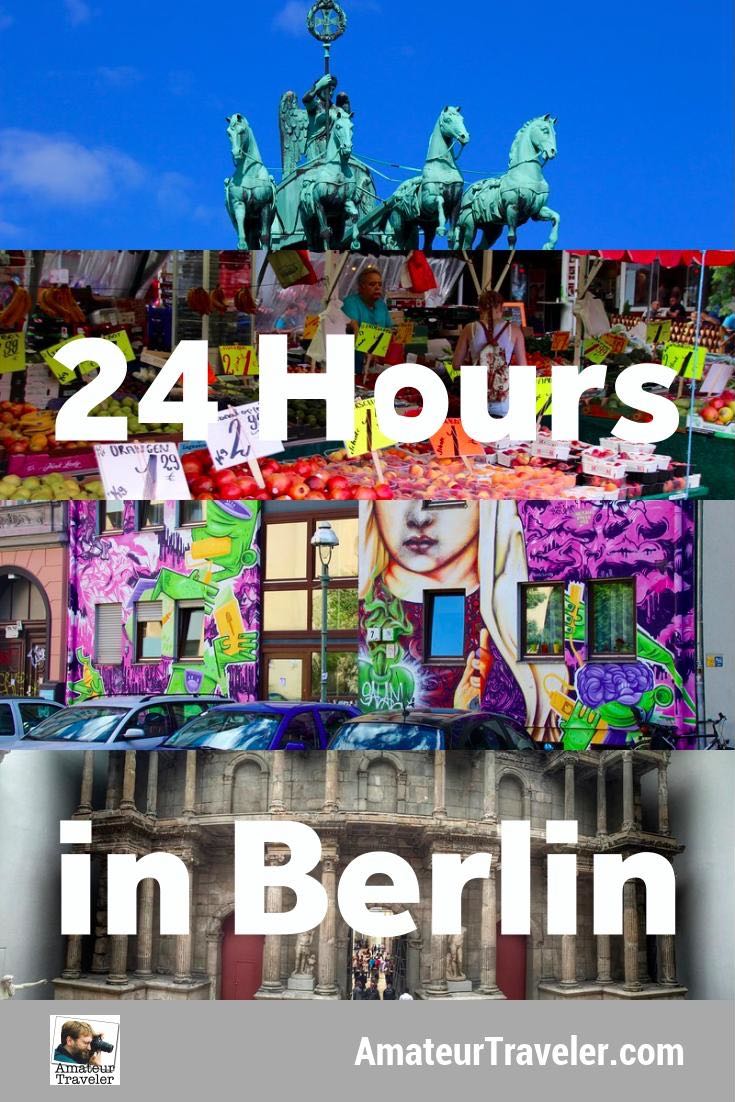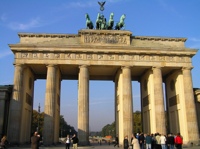24 Hours in Berlin, Germany
categories: europe travel
At the beginning of a press trip that I am on this week in Germany I had 24 hours to enjoy Berlin. 24 hours was just long enough to see some of my favorite sites again and to join a walking tour through Context Travel to get a deeper look at one of Berlin’s most interesting neighborhoods.

Brandenburg Gate Area
My first trip to Berlin was shortly after the wall fell so the area around the iconic Brandenburg Gate is still special to someone like me who grew up when Berlin was a divided city. I did not get any unobstructed pictures of the gate on this trip as they were preparing for some big event. What was once a place of division is now apparently the perfect place for a party.
Right next to the gate is also the Remodeled Reichstag building with its beautifully clear dome that lets visitors look down on the German lawmakers with a transparency that is both literal and symbolic.
The Memorial to the Murdered Jews of Europe is close by the Brandenburg Gate as well. This evocative memorial deserves a visit, even a quick one.
Museum Island
On our last trip to Berlin, we ended a walking tour on Berlin’s famous Museum Island, but by the time we got there all the museums had closed so I planned my day to arrive when the museums opened at 10:00 am. At the top of my list was a visit to the Pergamon Museum.

Even though I could not visit the namesake Pergamon Alter because of renovations, the museum has 2 other “wow” exhibits. The first of these is the Ishtar Gate from the ancient city of Babylon. The museum recreates the gate and the entrance street and gives you the sort of humbling “here lives the great King of Babylon” moment that the builders originally intended.

The back of the gate of Ishtar is not the city of Babylon but another impressive gateway from the ancient market of the Roman city of Miletus.
I also visited the New Museum to see, among other things, the bust of Queen Nefertiti of Egypt. The many archeological treasures on Museum Island are a tribute to the work of German archeologists who helped create modern archeology.

Kreuzberg
The second half of my day was highlighted by a walking tour of the neighborhood of Kreuzberg called “Everyday Life in Kreuzberg”. My tour was with and provided by (paid for) Context Travel. I had reached out to Context as a way to do a deeper dive than most tours provide. They have tours provided by experts, like an architecture tour being given by an architect or an archeology tour led by an archeologist. This particular tour was led by Chris Benedict who is not only a long time resident of the neighborhood but one who had worked for some time for the local neighborhood improvement project.

Kreuzberg is an old working-class neighborhood that sat up against the wall in the divided Berlin. It has always had many immigrants, formerly Jewish but now more Turkish. It has the most mosques, the highest unemployment and poorest schools of Berlin neighborhoods but also has a thriving art scene and is a center for nightlife. It is both a bit sketchy and a little bit trendy. It’s Facebook relationship status with the rest of Berlin would be “it’s complicated”.

We started the tour at an “underground” station which in Kreuzberg is not underground. I was handed a flyer for cannabis and walked past a few youths that seemed to be running some sort of racket before I even left the station. I never felt unsafe, even walking down allies but might have felt different at night.
From the street, it is not obvious that behind some of the ornate facades were originally more houses for workers as well as small factories. Knowing which alley to duck down is part of the fun of exploring the neighborhood. We visited one of the many blocks where squatters took over buildings in the 1990s when the official plan for Kreuzberg called for tearing it down and replacing it with apartment complexes like the crumbling ones that surround the U Bahn station of Kottbusser Tor. Much of the character of the Kreuzberg neighborhood would have been lost without some civil disobedience.

- Get a universal plug adapter
- Get a Car Rental
- Search for Great Tours HERE
- Book Your Accommodation HERE
- Buy Travel Insurance
- Get an eSim to be able to use your smartphone abroad.

But we also visited sites where the nearly annual May Day protests would pit locals vs the police. Even now when May Day is more about celebrating and less about rioting, the neighborhood resists changes. Chris said that when she was working with the community improvement project, some residence would vandalize anything that looked like gentrification out of the fear that it would drive out the poorer mostly immigrant population.

We visited a weekly market, saw people floating on one of the canals, walked by sidewalk cafes, but also walked past ever present graffiti, most of it not the artistic kind. Kreuzberg has a former hospital turned into an art center and a tiny house built on what somehow was unclaimed land near where the wall used to be. It has some lovely art deco buildings and some that would have been considered dreary even if they had been built on the GDR side of the wall.


Kreuzberg is a neighborhood in transition, despite itself. It is, to some degree, some of the immigration issues in Germany in miniature. It is dynamic. It is frustrating. It is an interesting neighborhood to explore if you find yourself in Berlin.
My thanks to Visit Berlin who put me up in the wonderful and wonderfully convenient Amano Grand Central (check prices) (see reviews) which is across the street from the main train station to Context Travel for offering this tour, and to airberlin who flew me to get to Berlin.

+Chris Christensen | @chris2x | facebook
4 Responses to “24 Hours in Berlin, Germany”
Leave a Reply
Tags: article, berlin, context travel, day tour, germany, walking tour

 Travel to Berlin, Germany – Episode 40
Travel to Berlin, Germany – Episode 40 Checkpoint Charlie, Looking in Different Directions – Berlin, Germany
Checkpoint Charlie, Looking in Different Directions – Berlin, Germany A Cold War Tour of Berlin – The Best Sites for History Buffs
A Cold War Tour of Berlin – The Best Sites for History Buffs 10 Crucial Things to Know Before Going to Berlin, Germany
10 Crucial Things to Know Before Going to Berlin, Germany

Richard Y.
Says:June 19th, 2016 at 1:49 pm
I’ve been to Berlin a half dozen times in the past 18 years, the last being last year (2015). The city is amazing and BIG. When we first went there in 1998, it was soon enough after the wall falling that there was nothing but construction happening. We stayed technically in East Berlin. We went to dinner with a group that night in what was a very small bar with food service. The BEST food I’ve had anywhere. I have no idea where it was or how we found it. But, wow…There is a major difference at the area of the wall now versus 1998. A lot of new construction right around Brandenburg Gate. One of the most interesting cities in the world.
chris2x
Says:June 19th, 2016 at 11:05 pm
When I was there in 1991 there were still Russian soldiers in East Germany and people selling border guard hats at the gate. You could still see the bullet holes in many buildings from WW2.
melanie ferguson
Says:October 7th, 2019 at 3:38 pm
My first visit was to East Berlin in 1989, a month before the wall came down. After the fall, we moved to Berlin as my husband was a journalist covering the economy and unification. We left in ’93, and I’ll be going back for the first time next week. I’m expecting lots of changes!
Chris Christensen
Says:October 8th, 2019 at 9:29 am
Wow, yes, lots of changes since 1993!